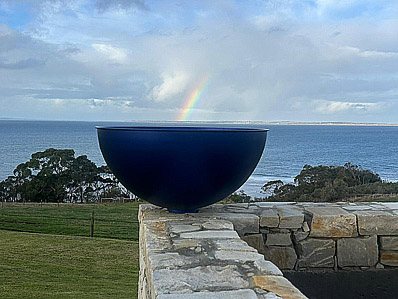| Biographie |
| Katazuke |
| Installation |
| mit Architektur |
| Bühnenbild |
| Photographie |
| Malerei |
| Aktuell |
| Kontakt |
From: Kazuo Katase
Katazuke – Autobiographical Forming, Wiesbaden 2018
In 1987 I installed a bowl made of blue aluminium upon an old water basin in the Swiss alps and titled the work Trink eine Tasse Tee (Drink a Cup of Tea), referencing a poetic statement by Zen monk Sengai. 30 years have passed since then. At the time, myself had “not arrived” yet. However, it was as if a guiding idea had risen from my heart and put itself intuitively into practice. These “projections” happened without having arrived yet. Today, my Self “has arrived, returned home and is without anything else”. My character has made me recognize this projection. The seed of consciousness (ālaya-vijñāna), the root of the life sense (manas-vijñāna).
From blue colouring to white light – this development was like a rainbow through a ray of light that pierces through a crystal. As such, my artistic path returned to an era of colour. This was accompanied by the form of a bowl in a semi-circle shape in “relation” (aidagara) to colour. A quarter of a century has passed and this image in my memory has determined the form of my paintings. It has accompanied me until now: it became a sculpture, photographic works and it even experienced a “metamorphosis”, taking the shape of a bowl. “A [sprouting] seed”. A long time ago, at the shore of Neranjara river in Bodhgaya, the handouts of young Siddharta, who was absorbed in yoga meditation floated down the river. However, they returned through the back current. The reversal of “form” and “colour” in my art and the experiences and conditions that my artistic path is based on repeat themselves over and over again whilst becoming more intensive and dense at the same time. Starting again with painting in 2010 led to the Mu-wan (Empty Bowl) series of works. In 2012 in the Josef Albers Museum I realized an exhibition of these paintings.
From the ashes of Ganges Ghat in Varanasi the birds of the phoenix fire flew up towards heaven. From the grey, colour flew out. At river Ganges, no, close to river Fulda in Kassel, I just play with colour. At the side of the goddesses in their saris working in the green fields, I remembered how I used to play in the water of the Katsumata river estuary in my hometown.
Life is a “path”. Well, I am alone and own only “nothing”. On the path of creation there are “inspiring encounters and relationships” and people who accompany me. In this way, there exist “relationships” (aidagara).

Drink a Cup of Tea, 1987/2025,
Shoreham, Australia, John + Myriam Wylie Collection